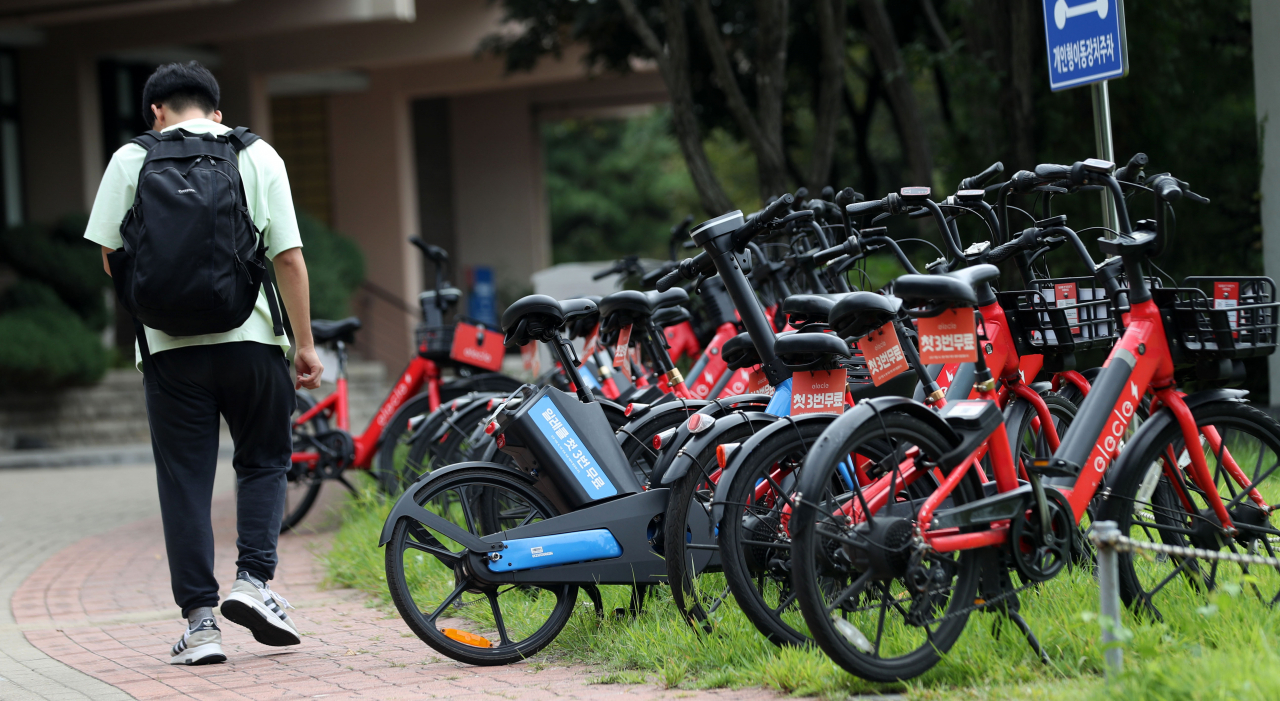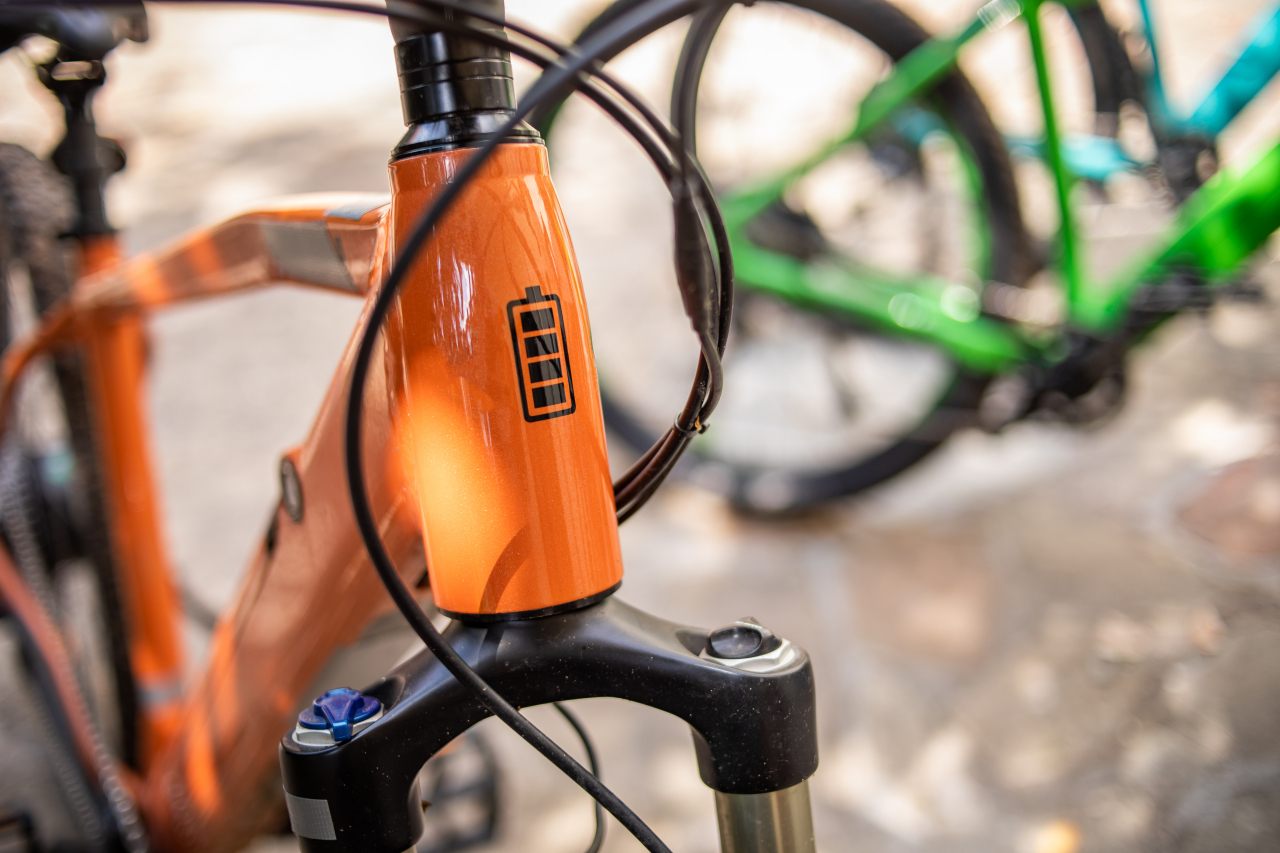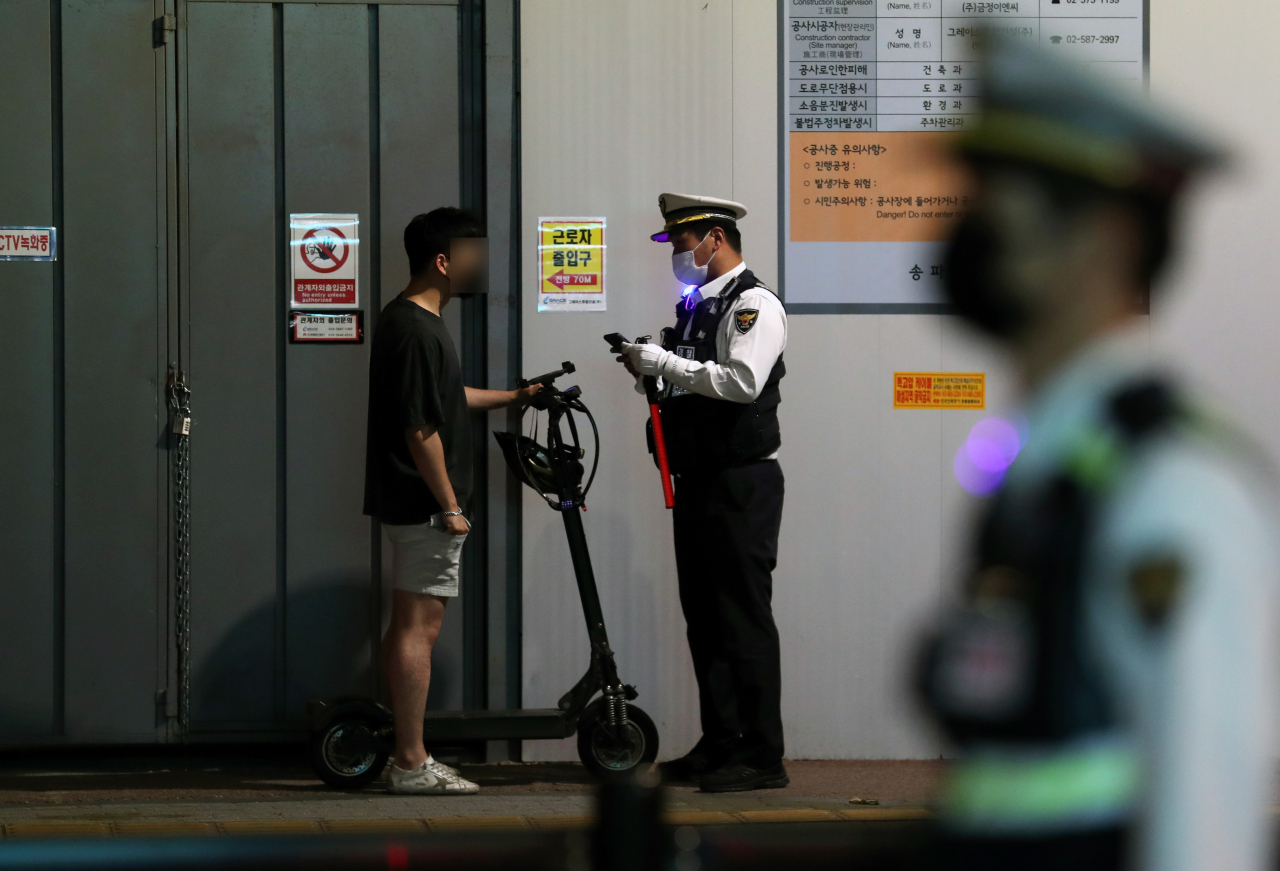Bikes or motor vehicles? E-bike use on rise amid classification ambiguity
Electric bicycles take over streets as the new face of last-mile transportation after strict regulations pushed e-scooters out
By No Kyung-min
Published : Nov. 14, 2023 - 15:53

Electric-powered bicycles, one of the most recent additions to South Korea's urban landscape, are quickly becoming a popular choice for short-distance travel, with many seen parked on streets and sidewalks across the nation's cities.
Replacing e-scooters, which once dominated Seoul's micromobility scene, e-bikes are enhancing public accessibility through affordable bike-sharing services.
Micromobility refers to lightweight, single-person vehicles that are used for transportation over short distances.
Kim Ji-min in her 20s is a frequent user of Elecle, an e-bike sharing service operated by local firm Nine2one.
“Renting an e-bike during morning rush hour saves time, as I don’t have to wait for the bus,” Kim said.
A typical 5-minute ride costs around 1,000 won ($0.75), with fees charged based on the ride duration, ranging from 60 won to 150 won per minute.
Some e-bike advocates look beyond renting, and instead choose to buy e-bikes to fully leverage their benefits.
"My decision to purchase an electric bicycle was based on convenience and cost-effectiveness," said Chun Min-kyu, in his 20s, who uses it for his daily commute.
"(The bike) is less affected by traffic during morning rush hour, and, more importantly, (it requires) less effort, as it moves much faster than a conventional bicycle."
Some even say that e-bikes have a promising market in South Korea, which is transitioning into a super-aged society, noting that motorized bikes might better meet the mobility needs of the elderly.

Growing presence
Although there are people like Chun who own an e-bike, the increased sightings of these motorized two-wheelers are mainly due to the proliferation of bicycle-sharing services, such as Kakao T Bike, Nine2one, Swing and Kickgoing.
The industry’s largest company, Kakao Mobility, which operates Kakao T Bike, inked a deal worth 16.8 billion won with domestic bike company Alton Sports in December 2022 to expand the supply of e-bikes.
The industry's No. 2 company in terms of business size, Nine2one, which operates Elecle bikes, recorded a 208 percent jump in revenue in 2022 to reach 11 billion won.
Electric bikes commonly come in two types: those with a pedal assist system and those with a throttle.
Most shared e-bikes are PAS models, activating the motor only through pedaling, unlike throttle models that move the bike forward without pedaling using a handlebar-mounted throttle.
While throttle models are classified as personal mobility vehicles like e-scooters and are subject to the Road Traffic Act, PAS models are considered regular bicycles under current traffic laws.
Since shared e-bikes are PAS models operating under more lenient regulations, riders have been more attracted to electric bike-sharing services to take advantage of their eased rules.
Unlike users of PM vehicles such as e-scooters and throttle-based e-bikes, who are required to wear helmets and hold at least a class 2 driver’s license for motorcycles, individuals over 13 can access e-bike sharing services without a driver’s license. Helmet use is mandatory, though violators are not penalized.
Kim Young-hoon, communications manager at personal mobility vehicle operator Swing, mentioned that people face fewer hurdles when renting e-bikes.
“The increasing number of e-bike riders, especially those without a driver's license, can be attributed to the lax regulations on PAS e-bikes and to the sense of safety e-bikes provide compared to smaller e-scooters," he said.
Moreover, shared e-bikes are not subject to tow zone demarcations under Seoul City's guidelines.
Unlike e-scooter users, who must be cautious about avoiding nine specific zones, and who risk having the e-scooter towed and a facing a fine of 40,000 won if they park the scooter in the wrong area, e-bike riders have more flexibility in choosing parking spaces since there's no strict legal enforcement regarding their parking.
However, given that e-scooters lying on pedestrian pathways and hindering people's movement led to public nuisance complaints, and in part, prompted the tightening of related regulations, the rising popularity of shared e-bikes runs the risk of potentially encountering a similar issue.
Kim from Swing agreed that the larger size of electric bikes might lead to more issues in blocking pedestrian pathways.
"When we replace batteries in electric bikes, we move bikes parked in narrow alleys to more spacious areas because their large size obstructs the passage (of pedestrians)," he explained.
Indeed, according to data from the Korea Consumer Agency in March, more than 60 percent of 346 cases of complaints related to e-bikes had to do with improperly parked shared electric bicycles obstructing pedestrian traffic, with about 25 percent interfering with traffic flow near bus stops or roadsides.
Additionally, more than 42 percent of 500 e-bike users in a related survey identified areas, such as within 10 meters of a bus stop or near subway station exits, as suitable parking spaces, without acknowledging that they might obstruct traffic.
In light of this, the agency strongly encouraged electric bicycle sharing service providers to offer detailed guidance on suitable parking locations.

Ambiguous identity
For e-bikes to emerge as a suitable micromobility option for the masses, experts say that we must address the ambiguity surrounding their identity, as well as regulations and public perception,
Distinguishing between the two different models of e-bikes -- the PAS and throttle types -- and enforcing the helmet regulation, for instance, is nearly impossible without actually riding the e-bike. This challenge is expected to become even more complex due to the presence of electric bicycles that support a dual mode, allowing both functions.
Moreover, experts argue that the division between the two types of e-bikes in terms of regulations may result in more confusion among the general public not familiar with e-bike classifications.
"It would be logical to place both types of e-bikes under one category to prevent potential confusion about relevant regulations,” said Jeong Gyeong-ok, a senior researcher at the Korea Transport Institute.
Yet, unlike some who believe that PAS models should be classified as PM vehicles like throttle models for parking and safety reasons, the Ministry of the Interior and Safety remains cautious on the issue.
“Discussions are underway at the Ministry of the Interior and Safety regarding the Act on Encouragement of Bicycle Riding to include both types of e-bikes under the same act. However, the controversial issue remains as to whether they should still be regarded as two different models or simply as one type of electric bicycle," Jeong said.
Certain ride-sharing operators argue for maintaining the status quo, asserting that the operating methods of throttle models and PAS models inherently differ, with the latter involving human power while the former does not.
On the other hand, those who argue that PAS e-bikes should be classified as PM vehicles highlight their similarities to e-scooters.
A 30-something office worker surnamed Oh voiced his confusion over the differing regulations between shared e-bikes and e-scooters.
"I consider PAS electric bikes and e-scooters to be fundamentally similar," he said. "They are both electric modes of mobility vehicles with the same speed limit of 25 kilometers per hour."
If shared e-bikes were to be classified as PM vehicles, adhering to the same regulations as e-scooters, it is still the riders’ responsibility to comply with the rules, including wearing helmets, parking in designated areas and refraining from using pedestrian walkways, Kim from Swing said.



















![[Today’s K-pop] Treasure to publish magazine for debut anniversary](http://res.heraldm.com/phpwas/restmb_idxmake.php?idx=642&simg=/content/image/2024/07/26/20240726050551_0.jpg&u=)